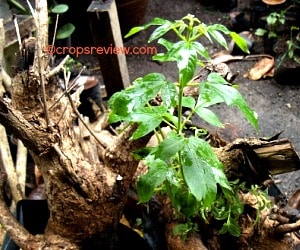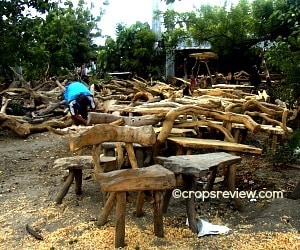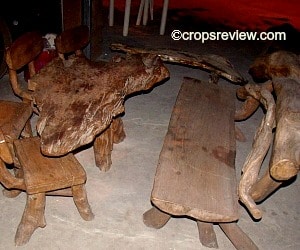The molave trees are uniquely versatile and should deserve more vigorous attention.
Their specific uses are so numerous that it is quite impossible to make a complete list.
To generalize, they are used in the form of round logs or posts, sliced lumber, driftwood, or intact live plants, and also as fuel, fodder for livestock, and herbal medicine.

These trees must have been used a thousand different ways in the distant past.
Some logs or lumber have survived the ravages of time and seem to have surfaced to declare that they are part of the country’s historical heritage.
In 1990, ancient dug-out log coffins were discovered in Panhutongan, Surigao del Norte.
The pit burials were of the period 16th to 17th centuries AD, but wood from one coffin was radiocarbon dated to AD 140±390.
It was established that at least one of the coffins was of molave wood (De la Torre 1996).
There also are those ”hand-carved 17th-century seats of molave” in the choir loft.
These are found in the San Agustin Church in Ilocos Norte, built from 1694 to 1710 and now one of the Baroque Churches of the Philippines declared a World Heritage Site by UNESCO (Wikipedia 2013).
I wouldn’t be surprised if these massive churches were built with some pieces of molave log or lumber.
In my grandfather’s hometown in Matalom, Leyte, there is that magnifescent baroque church at the center of town. It was constructed in the 1800s.
 |  |
The church has a tall bell tower at one side to the left of the main entrance.
To my recollection, the church had walls about 1 meter thick made of large blocks of limestone rocks piled upward, with reddish-brown roofing made of clay.
I was then so agile in my teens and I made it one of my pasttimes to collect guano.
It’s amazing how in just a few days a small amount of guano could trigger a vigorous growth response from pechay.
I collected guano which accumulated on the ceiling of the church and used it to fertilize the vegetable plants in my garden plot.
I found a way to climb upward through the bell tower, treaded through a narrow ledge up on the front wall, and then entered into the ceiling via an opening vertically aligned to the main entrance.
There inside supporting the roof but concealed from below by the ceiling are those large wooden trusses made of molave lumber.
Indeed, the versatile uses of molave trees find application in the construction of massive structures.
In my mother’s hometown in South Cotabato, now Sarangani, our wooden two-story ancestral home still stands.
The posts, stair, a door, and most of the flooring are made of molave lumber that was sliced using the two-man saw, also referred to as the you-pull-I-pull saw of the old days.
There is still the molave pestle (lusong), consisting of a section of a trunk in which a hollow was carved inward.
In the past this pestle and a wood mortar were used in pounding upland paddy rice to separate the grains from the hulls, in processing pinipig, in extracting the beans from coffee berries, in “finishing” large corn grits to remove the sharp texture after cooked, and in preparing banana nilusak.
This wood pestle has already moved to the city.
We still use it, though only occasionally, to pound small quantities of coffee berries harvested from a few trees in the farm.
The small cabinet with baroque-inspired legs, which my grandfather himself built, has likewise survived. It too has migrated to the city and remained useful.
It is obvious, however, that the versatility of molave trees has further evolved.
The molave bonsai using the tugas lanhan type has become one of the favorites in the art of plant miniatures.
In addition, aged and rotted parts of the tree, including stumps and those crooked or twisted stems and branches, have found new uses in furniture making, accents, and other artistic creations.
Those rotted, rugged, crooked, irregularly shaped hardwood rejects of the past have transformed into one of the most unique, eye-catching, high-priced markettable works of art of today.
Unfortunately, it is only the molave tree of the tugas lanhan type which produce those crooked stems and branches, and hard and resistant to rotting too, in sufficient quantity.
Wide, flat platforms with irregularly shaped edges can be obtained from other tree species, but not those uniquely shaped branches.
Consequently, the surge in demand has led to the depletion of the natural stands of the tugas lanhan.
Worst, the tree’s natural habitat is not only replanted, it is rapidly being invaded by the neem tree (Azadirachta indica).
Now, why doesn’t anyone who is able to create the supply? Or at least give it a serious thought?
Molave trees should also be a viable alternative for tree planting and agroforestry.
With its long life span, versatile uses, and resistance to rotting, it should likewise be an ideal choice for carbon sequestration to mitigate global warming.
As to planting materials, the molave tree can be mass propagated using seeds and stem cuttings.
LITERATURE CITED
DE LA TORRE AA. 1996. The Surigao del Norte archaeological project. Indo-Pacific Prehistory Association Bulletin (Chiang Mai Papers). I(14): 177-185. Retrieved Aug. 28, 2013 from http://ejournal.anu.edu.au/index.php/bippa/article/viewFile/443/432.
WIKIPEDIA. 2013. Architecture of the Philippines. Retrieved Aug. 28, 2013 from http://en.wikipedia.org/wiki/Architecture_of_the_Philippines.
